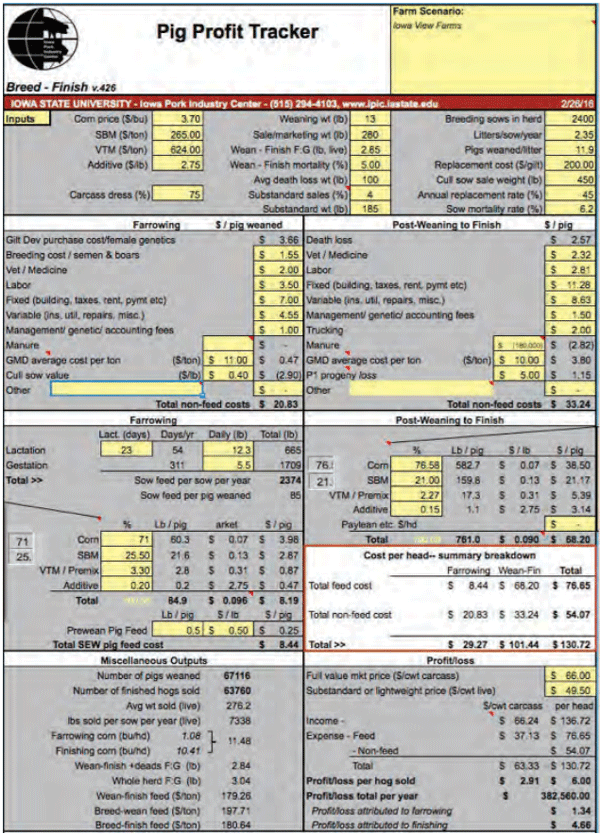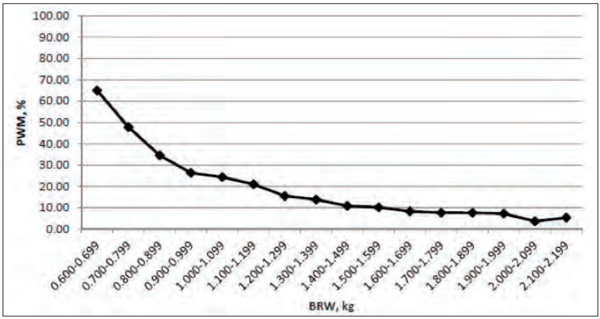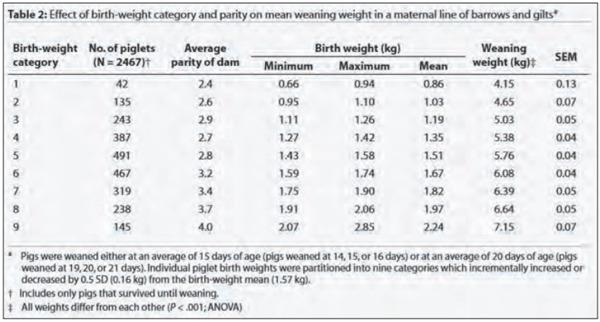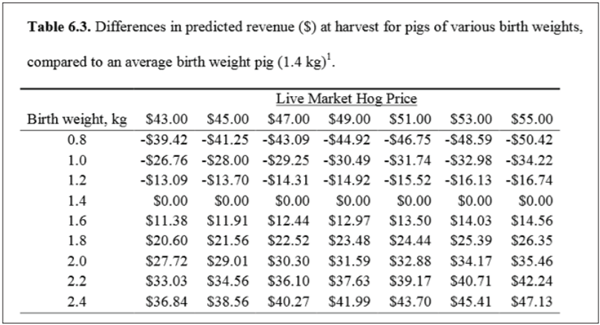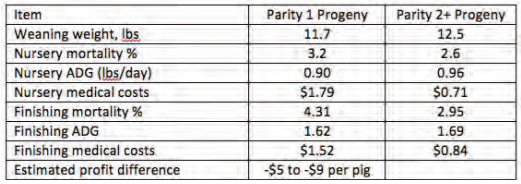There are several different genetic technologies that have been used to improve trait performance for pig farmers. Some examples would include:
a) Terminal Cross Mating System: this is simply using a crossbred female composed of breeds that are best for reproduction as the maternal line animals. The most common examples are the use of a Landrace/Large White F1 female as the parent female. This allows the best breeds for reproduction to exert their strengths, and takes advantage of the heterosis that is expressed by the F1 female for reproductive traits.
b) Optimal Genetic System Structure: this is where the production farm uses the proper number of GGP, GP and Parent Stock females in the genetic system. Usually at least 10% of the female herd should be in the GGP and GP roles. These maternal females then are mated to a breed or line of terminal boar that best fit the needs of the producer. The most common terminal breeds are the Duroc, Pietrain, or composite terminal lines. This allows for the producer to take advantage of both maternal heterosis in the females, and heterosis for terminal traits in the market hogs.
c) BLUP based selection programs: in order to maximize the genetic progress from selection, particularly in the maternal lines, we must use the most accurate method for estimating genetic merit in the animals eligible for selection. The BLUP system of breeding value estimation is the most accurate system available, and can be used by both the genetic supplier and the commercial producer to improve the traits of economic importance.
d) Marker Assisted Selection: we can now identify individual genes that have a major influence on certain traits of economic importance, such as litter size, feed conversion and meat quality. However, the genetic assay is somewhat expensive and is usually done by the genetic supplier, but the commercial producer is the one that enjoys the benefits.
e) Mate-Select Software: it is now possible for the genetic supplier to use software that can structure the matings made at the GGP level to produce the most extreme progeny from the pure line matings, while minimizing inbreeding. This is very important in the production of the most extreme boars for AI usage in both the maternal and terminal lines. This is usually employed by the genetic supplier and the results are then relayed to the commercial producer.
f) Genomic information: it is also now possible to genotype GGP animals for a large number of gene pairs, in excess of 60,000 genes for one animal. The cost of this is still quite high, but it can result in a significant increase in the accuracy of BV estimation, but due to cost, is employed at the genetic supplier only.
It is now possible for the commercial pork producer to reap the benefits from all the above genetic technologies, either directly using them, or having their genetic supplier use them.
In terms of improvement in performance of key swine traits, over the past 30 years we have seen:
1. Litter size has increased from 10 14 or more pigs/litter
2. Backfat has decreased from 25mm at P2 measurement 10mm or less
3. Lean meat percentage has increased from 45% 57% or more
4. Growth rate has increased from a 220 lb pig @ 7 months of age 285 lb pig @ 6 months of age
5. Feed conversion has improved from 3.50 lb feed/lb gain 2.50 lb feed/lb gain or less
While this is an overall positive change, in making genetic improvement we have to be aware of any possible ‘correlated responses’ to this genetic improvement in trait performance. Pearson (1903) and Robertson (1967) opined that “..individuals with intermediate trait values have higher fitness..”, and, “..extreme phenotypes cause reduced fitness..”.
For example, as litter size has increased, it has exceeded the uterine capacity of the sow, and as a result while more pigs are farrowed and weaned per litter, the number of piglets with low birth weights has increased. The potential impacts of this include an increased piglet mortality, and of those piglets that do survive to weaning have a higher percentage of pigs with sub-standard weaning weights.
Also, as backfat has decreased and lean meat percentage has increased and growth rate has increased, the percentage of animals that are more fragile and have more structural problems has increased. These negative correlated responses in fitness traits exert an economic impact with higher sow and pig mortality, higher sow culling rates, and an increased percent of sub-standard market hogs.
The overall goal of pork production is to maximize profit. So while there is a need to maximize the performance of key economically important traits in pork production, at the same time we must consider any potential correlated responses that might negatively impact profit.
Profit = Return > Cost of Production
Profit can be improved by either increasing the return from animals sold from the farm (by increasing reproduction, survival or growth), or by lowering the cost to produce the pigs (by improving feed conversion and reducing nonproductive sow days). In order to maximize the profit the pig farmer needs to know their cost of production, including the specific components. Software can be utilized to assist the pig farmer in knowing their cost of production, and to examine the overall benefits from changing any of the components. The software demonstrated below is PigProfitTracker© developed by the Iowa Pork Industry Center at Iowa State University, Ames, IA.
Figure 1: Example of cost of production/potential profit for use by swine producer.
At the sow farm, the capacity is usually determined by the desired output of market hogs and level of investment of the farm owners. The correct number of gestation spaces, farrowing spaces and gilt development spaces is based on the overall desired production capacity. The primary duties are to breed the sows, farrow the sows, wean the litters, then repeat the process. Consequently then the sow farm costs accumulate on a sow/day basis. The owner must feed the sows, pay for the facilities, labor, vet-med costs, gilt development costs, genetic costs and other variable costs. The returns from the sow farm then come from full value weaned pigs, marginal value weaned pigs, and cull sows that are sold.
There then are a number of variables or ‘traits’ that can influence either the cost or return at the sow farm. Returns can be increased by increasing farrowing rate, increasing the number of pigs born alive (of adequate size), decreasing piglet mortality, increasing piglet weaning weight or decreasing sow mortality and cull rate. Costs can be reduced by reducing non-productive sow days and by decreasing piglet mortality. Non-productive sow days are decreased when farrowing rate is increased and wean to service interval is decreased. In order to make genetic improvement in these traits, they must have adequate genetic control to respond to selection, and the pig farmer must use the correct genetic system to get heterosis for these traits. The traits that have been shown to respond to BLUP based selection include litter size, pre-weaning mortality, litter weaning weight, and litters/sow/year (as a way to indirectly improve farrowing rate). Sow mortality can be improved by phenotypic selection in structure and soundness.
Economic Impact of Piglet Birth Weight:
I have used the term ‘number born alive of adequate size’ as a trait to be selected for. We have seen tremendous genetic progress in litter size since the implementation of BLUP based selection. However, as we have increased litter size above 12 NBA, the number of pigs with birth weights less than 1 kg has increased, along with piglet mortality. This is due to the litter size exceeding the uterine capacity of the sow, with pigs in large litters getting less pre-natal nutrients from the sow’s uterus, resulting in more pigs that are smaller at birth than desired.
People who have raised pigs have long realized that the birth weight of a piglet is associated with it potential to make a profit for the pig farmer. The lifelong pathway of commercial pigs is shown in the diagram below:
Research has shown a strong relationship between the birth weight of a piglet and its survival rate, weaning weight, market weight, and potential profitability
The table below shows the relationship between piglet birth weight and survival rate (Dufrasne et al, JAS 2013).
If the piglet has a birth weight in excess of 1.4 kg then the pre-weaning mortality is less than 10%. If the piglet has a birth weight of less than 1 kg, then the pre-weaning mortality is very high, in excess of 25%. Based on these results, it appears that a reasonable target for piglet birth weight of 1 kg and higher will keep pre-weaning mortality at profitable levels.
Research done by Smithfield Premium Genetics® and published by Dr. Justin Fix of North Carolina State University (Fix, et al 2010) examined the relationship between piglet birth weight and weaning weight at 3-4 weeks of age. Their results are shown in the table below:
They weighed more than 2400 piglets at birth, assigned them to birth weight classes, and then followed their weight at weaning. A linear relationship was found between piglet birth weight class and piglet weaning weight. Most noticeable was the weaning weights of less than 5 kg for piglets with birth weights less than 1 kg on average.
The authors also followed the pigs from weaning to market and tracked the cost and return of each piglet. They measured the piglets post-weaning mortality, growth rate and feed conversion, and eventual return when marketed. These results are shown in table below:
Based on these results, using input costs from the USA in 2010, it is clear that as the birth weight of the piglet increased, the profit of the pig at market weight also increased significantly.
The results from Fix et al (2010) can be used to develop regression effects of piglet birth weight on economically important traits such as pre-weaning mortality, post-weaning mortality, market weight, and the percentage of ‘Full Market Value Pigs’. The results showed that as pig birth weight got below 1.4kg the chance of profit got less probable. Their research suggested that for each decrease in piglet birth weight of 0.1kg (below 1.4kg) the pre-weaning mortality increased by 3%, the post-weaning mortality increased by 2%, market weight decreased by 1.63 kg or 3.6 lb, and the probability of it being a ‘Full Market Value’ pig decreased by 2%. They defined a ‘Full Market Value’ pig as one that weighed more than 200 lbs (90kg), had no injuries, ruptures or other defects, and received full market value at the slaughterhouse. A pig that was not ‘Full Market Value’ received a discounted market price of 75%.
Using the above research based information, we can estimate the profitability of each birth weight class (1.4kg, 1.3kg, 1.2kg, 1.1kg, 1.0kg) using the PigProfitTracker® software. This software uses farm specific cost of production inputs, and user inputted performance and price information. A market carcass price of $84/cwt was assumed for FMV pigs, and $63/cwt for non-FMV pigs. A feed cost of $0.12 was used.
The table below shows the relative performance and estimated profit for each birth weight class of piglet:

Based on the this information, as a piglets birth weight declines from 1.4kg down to 1.0kg, the average profit per pig also declines. And based on the information and assumptions in this table, piglets with a birth weight of 1.0kg or less will not produce a profit for the pig farmer. How does this then impact the genetic supplier? Over the past 10 years the genetic merit for litter size has increased greatly; however, the number of piglets with low birth weights has also increased as the litter size has exceeded uterine capacity of the sow. How should the genetic supplier account for this increase in low birth weight pigs in their genetic improvement program? A logical solution is to only give born alive credit to those pigs that have an adequate birth weight to be profitable. Therefore, the move towards selection for litter size born alive with birth weight above 1kg is recommended for use in improving profitable litter size in pigs.
Economic Impact of Sow Culling Rate and Sow Mortality Rate:
When a sow goes out of service from the breeding herd, either by voluntary culling or dying, there is a cost to the farm. Even if the farm is raising their own replacement gilts, these events incur a cost to the farm. The traditional comparison when making a decision to cull a sow has been to compare the performance of a ‘potential cull’ sow to that of a replacement gilt. For instance, if the performance of the older sow is 10.5 born alive and 80% farrowing rate; and, the performance of the parity 1 replacement gilt is expected to be 11 born alive and 88% farrowing rate, most herds have chosen to cull the older sow.
However, there is another factor to consider in making this decision: the performance and profitability of progeny from the parity 1 sow compared to those progeny from parity 2+ sows. Klobasa et al (1986) reported on differences in immunoglobulin synthesis in first versus multi-parity sows. Deen (2002) reported that gilt progeny are more likely die in the nursery than sow progeny. Morales et al (2006) and Burkey et al (2008) showed an effect of sow parity on piglet health status. And Miller (2008) and Miller et al (2012) examined the poor growth and survival of the progeny of gilts. Research presented at the Leman Conference has shown that progeny from parity 1 sows have a lower weaning weight, higher mortality, lower growth rate and higher medical costs. The magnitude of this difference is shown in the following table:
So now when the producer considers voluntarily culling a sow, they should take into consideration the salvage value of the sow, the cost of the replacement female, the reproductive performance of the replacement female, and the reduced performance of the progeny from the first parity sow compared to the progeny from the mature sow.
There is a cost to both sow mortality and sow culling rate. If we consider the factors mentioned above, assume no difference in reproduction, use a $5 per pig reduced performance from gilt litters, and use the PigProfitTracker© software, the economic impact in a 2400 sow farm for a 1% increase in sow mortality is to lower profits by approximately $6057 per year. And the economic impact of a 1% increase in sow culling rate is to lower profits by approximately $1652 per year. When one considers how easy it is to see culling rate change by 5% or more, this economic impact becomes very significant.
Economic Impact of Post-weaning Mortality and Percent Full Market Value Pigs:
Within a commercial pork production system the size of the Grow-Finish farms is set by the sow farm size and pig flow. The pig farmer needs the correct number of nursery and finisher spaces (or wean-finisher spaces) to match pig flow from the sow farm. The role of these farms is to start the pigs on feed after weaning (the bigger the pig the better), then to sell the pigs when they reach the desired market weight. As a result, the growth rate, feed conversion and mortality of the pigs are very important traits. The return when the pigs are marketed are based on the number of pigs marketed with adequate size, as the packer will discount any pigs that are under a minimum market weight. There can also be some impact on price based on the meat quality of the pigs, but this is not usually a large impact.
So at the Grow-Finish farms, the fixed costs are based on the per head capacity of the farm, and variable costs are based on several factors for each pig, especially feed conversion and mortality rate and weight when mortality occurs. The return is influenced by the number of full value pigs marketed, the growth rate, and mortality rate. One important fact that bears mention here is that the pig’s genetics for post-weaning traits comes equally from the sire and dam of the piglet.
The economic value of post-weaning mortality is well recognized. When the pig is weaned, then moved to the grow-finish facilities, it is expected to eat feed, convert the feed to lean gain, and then be marketed as a full value market hog. When a pig dies after weaning it has incurred much of the cost of a market hog, but gives no value in return. Using the PigProfitTracker© software and an assumption that the average weight of post-weaning mortalities is 100 lbs, the economic impact of a 1% increase in post-weaning mortality is $30,914 for a 2400 sow breed to finish farm.
The economic impact of a pig failing to meet the ‘Full Market Value’ standards is not as well recognized. In this case the pig does not die, but also does not reach market weight of at least 200 lbs. When this occurs the packer discounts the price given to the pig by at least 25%. Using the PigProfitTracker© software the economic impact of a 1% increase in non-Full Market Value pigs is $28,682. While these pigs do generate some return, they are very inefficient in their growth and the reduction in market return is quite severe.
Current Popular Genetic Marketing Strategy:
Several genetic suppliers have focused heavily on improving litter size and pigs weaned per sow per year, in both their genetic improvement programs and in their marketing strategies. Many customers who have switched to these genetic suppliers have seen correlated responses in higher sow mortality, higher sow culling rates, higher postweaning mortality, and an increase in the percent of non-Full Market Value Pigs. What is the economic ‘trade off’ in this situation?
Using the PigProfitTracker© software, with a starting assumption of a 2400 sow breed to finish herd, and an economic assumption of $6/pig profit. Reproductive and performance starting points were 28 PSY, 45% culling rate, 6.2% sow mortality rate, 5% post-weaning mortality rate, and 4% of pigs were non-Full Market Value pigs as defined earlier in this paper. We then imposed three different scenarios with an increase of reproductive performance from 28 PSY to 31 PSY. In Case 1 (no correlated loss of fitness) we kept the sow culling and mortality rates, and pig mortality and nonFMV rates the same. In Case 2, we assumed a small correlated decrease in fitness traits, and in Case 3, a moderate decrease in the fitness traits. These results are summarized in the table below:
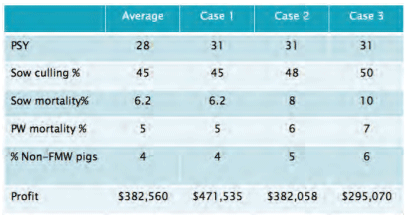
If we just increase PSY from 28 to 31 and assume no loss in the fitness traits, then profit from the farm increases by 23%, as shown in Case 1. However, if we assume a slight loss of fitness as shown in Case 2, the annual profit from the farm is essentially the same as our 28 PSY starting point. And if we assume a moderate loss of fitness as shown in Case 3, the annual profit from the farm is reduced by 30% from our 28 PSY starting point. It is not logical to assume we can increase PSY from 28 to 31 with no loss of fitness in the sows or pigs, so Case 1 would not be an expected outcome. The lesson here is that the producer needs to consider both the increase in reproduction from the 31 PSY sow genetics, but also the producer should consider what level of loss in the fitness traits for the sows and pigs would be expected under their farm management and environment.
At this point, let me summarize several of the ‘Take Home Points’ from this discussion:
- Over the past 30 years, the use of genetic technologies has made significant genetic improvement in reproduction, growth rate, feed conversion, and lean meat percentage.
- At the same time we have seen an increase in the percent and number of low birth weight pigs, which eventually have lower weaning weights, poorer survival, slower growth and less profit potential.
- Associated with this movement towards more extreme phenotypes we have seen a correlated reduction in the fitness traits of both sows and piglets (mortality rates, culling rates, sub-standard weaners and finishers)
- It is important that genetic suppliers include phenotypic structure in their genetic improvement programs as a way to minimize any loss of fitness.
- It is also possible for genetic suppliers to include fitness traits such as mortality rates and culling rates in their genetic improvement program, most likely through progeny test programs.
- For the commercial pork producer it is logical to focus their genetic program towards one that will maximize long term profits at their farm rather than chase short term improvements in targeted traits of current interest.
Presented at the 24th International Pig Veterinary Society Congress. For information on the next edition, click here. 